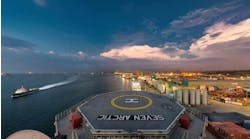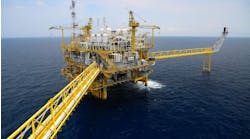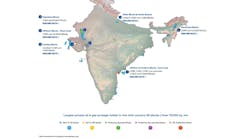Subsea 7, Schlumberger look to strengthen alliance with joint venture negotiations
Jessica Tippee Houston
Subsea 7 S.A. and Schlumberger have entered into negotiations to form a joint venture that builds on their Subsea Integration Alliance, which was established in 2015. Currently that alliance combines OneSubsea’s subsurface, subsea production systems and subsea processing systems capability with Subsea 7’s subsea umbilical, riser and flowline systems offering.
The proposed joint venture will place emphasis on strengthened front-end engineering, design and execution of integrated projects, creating a life of field package that will include autonomous subsea technology; digitally enabled remote surveillance and production monitoring; and inspection, maintenance and repair services.
In addition to contributing resources for early engagement and tendering, the two companies plan to assign their respective Life of Field businesses to the joint venture, which will be owned on a 50:50 basis.
Clients will remain free to purchase non-integrated products and services from any manufacturer and vendor.
Olivier Le Peuch, president, Cameron Group, Schlumberger, said: “Subsea Integration Alliance has already provided our customers with industry leading innovation and value. The proposed joint venture will give us the opportunity to capitalize on the synergies already established and significantly improve subsea economics over the lifetime of the field.”
Also, Subsea 7 has agreed to acquire a 60% interest in consultants Xodus Group from Chiyoda, with the latter remaining a 40% joint venture partner. Xodus will continue to operate independently of its parent companies, providing what Subsea 7 said would be unbiased engineering and advisory services to the energy industry and objective advice to help clients maximize returns from their projects.
Masaji Santo, president and CEO of Chiyoda, said: “Subsea 7’s experience and scale in offshore energy services will enhance Xodus’s capability and its global reach…”
Xodus says that it started the year off well, picking up more than £6 million ($8.3 million) of contracts and noting resurgence in front-end engineering projects as the North Sea undergoes continued recovery. The company recently expanded into the Egyptian market and manages various life-of-field projects through its London, Aberdeen, and international operations.
Small pools initiative delivering subsea solutions for UK fields
Wood Mackenzie and the Oil & Gas Technology Centre believe subsea advances and approaches could boost development of marginal fields on the UK continental shelf (UKCS).
According to the Centre, there are 3.4 Bboe in the UK’s undeveloped ‘small pool’ fields (discoveries containing less than 50 MMboe/P50 technically recoverable). This accounts for more than 10% of the 27 Bboe of small pools globally. At the current oil price, 1.5 Bboe of this resource could be potentially economic.
EC-OG’s Subsea Power Hub is an example of the technology being developed to unlock small pools. (Courtesy Oil & Gas Technology Centre)
The Centre’s ‘Tie-back of the Future’ initiative, which aims to halve the cost and time taken to develop small pools, would make an additional 400 MMboe. It brings together 25 operators, supply chain firms and technology developers, all focused on transforming the current approach to developing marginal fields, with subsea equipment is designed for disassembly and subsequent re-use.
Five technology projects are under way, with 13 technology proposals under review and six integrated studies completed.
Chris Pearson, Small Pools Solution Centre Manager for the Centre, said: “We are seeing developments in mechanical hot taps, mechanically connected pipelines, multi-use pipelines, the integration of renewable energy systems and unmanned facilities.”
Mhairidh Evans, principal analyst for Wood Mackenzie, said: “At current exploration rates, it would take 14 years and 500 wells to find the same volumes that have already been discovered in small pools. As a mature basin, these barrels can no longer be ignored.
“As well as providing much-needed new investment, unlocking small pools is key to extending the life of existing infrastructure.
“The UK industry, with the Technology Centre’s backing, is at the forefront of these new technologies. Approaches taken here will be much-watched and learned from around the globe.”
Operators supporting subsea equipment reliability project in Australia
National Energy Resources Australia (NERA) is providing A$145,000 ($115,000) of funding for the Transforming Australia Subsea Equipment Reliability (TASER) project. Wood is leading the program in collaboration with Chevron, Shell, and Woodside.
TASER is a follow-up to the Subsea Equipment Australian Reliability joint industry project also led by Wood and supported by various operators.
The main goals are sharing knowledge to improve subsea equipment design and reducing the need for costly and time-consuming interventions in Australia’s challenging offshore, warm water environment.
Offshore northern Australia, marine fouling impacts the performance of subsea equipment, probably due to the combination of the water composition, light, oxygen, and temperature. TASER will create a ‘living laboratory’ to assess the effectiveness of novel coatings, materials, and technologies against calcareous deposition and marine organism growth on subsea equipment.
Robin Watson, Wood’s chief executive, said: “The project will enable a better understanding of subsea equipment failures and intervention requirements and has the potential to offer significant cost savings to operators by maximizing equipment reliability, availability and therefore production uptime.”
NERA chief executive Miranda Taylor added: “Digital technologies and ‘living laboratories’ allow faster, safer adaption, testing and application of the technologies needed to optimize performance of the oil and gas industry’s subsea equipment.
“NERA is supporting the TASER project as it will bring operators and vendors together to share, collaborate, and address industry challenges in real life conditions.”
Various vendors are loaning equipment to be tested underwater over a three-year period, with University of Western Australia researchers validating the results.





